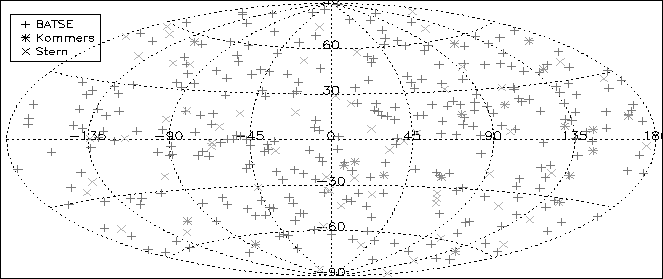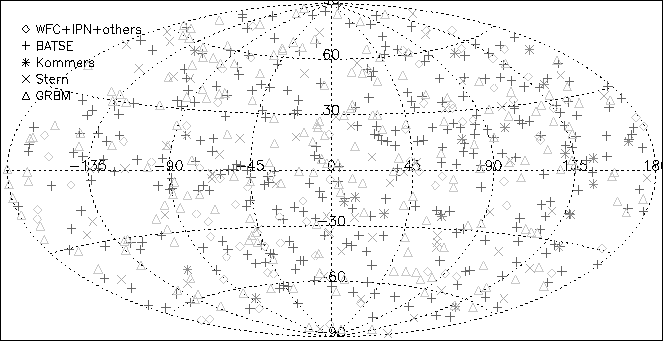



Next: GRBM Localization Technique Limits
Up: The GRB Catalog
Previous: HR Distribution
Contents
For 441 out of 944 GRBs reported in out GRB catalog,
an estimate of the arrival direction, even with
variable accuracy, was available from other instruments (WFC, ...).
The localization technique based on the GRBM data, applied to
all the 944 GRBs of the GRBM catalog, gave the following results:
a unique and acceptable solution only
for 446 out of the initial 944 GRBs ( 47%).
These 446 GRBM-localized GRBs split into the following classes:
152 in common with BATSE 4B, 10 with Kommers', 41 with Stern's,
45 with the well localized GRBs (mainly WFC + IPN); the
remaining GRBs, amounting to 446-152-10-41-45=198,
have been detected and positioned by the only GRBM, with no
possibility of cross-checking with any other independent detections.
In table
47%).
These 446 GRBM-localized GRBs split into the following classes:
152 in common with BATSE 4B, 10 with Kommers', 41 with Stern's,
45 with the well localized GRBs (mainly WFC + IPN); the
remaining GRBs, amounting to 446-152-10-41-45=198,
have been detected and positioned by the only GRBM, with no
possibility of cross-checking with any other independent detections.
In table ![[*]](crossref.png) the situation is summarized.
the situation is summarized.
Table:
GRB positioned with the only GRBM.
| Experiment |
# GRBM-positioned |
# Total |
GRBM-positioned |
| |
GRBs |
detected |
GRBs fraction |
| Well Loc. |
45 |
79 |
57% |
| BATSE 4B |
152 |
283 |
54% |
| Kommers' |
10 |
18 |
56% |
| Stern's |
41 |
61 |
67% |
| Only GRBM |
198 |
503 |
39% |
| Total |
446 |
944 |
47% |
From table ![[*]](crossref.png) it comes out that,
on average, the GRBM localization technique can yield a unique
and reliable position for
it comes out that,
on average, the GRBM localization technique can yield a unique
and reliable position for  50% out of the GRBs included in our
catalog. Out of the 503 GRBs detected by the only GRBM, 503-198=305
GRBs cannot be positioned with a unique and reliable direction,
due to the GRBM response function ambiguity.
In such cases, more than one direction is available.
(sec.
50% out of the GRBs included in our
catalog. Out of the 503 GRBs detected by the only GRBM, 503-198=305
GRBs cannot be positioned with a unique and reliable direction,
due to the GRBM response function ambiguity.
In such cases, more than one direction is available.
(sec. ![[*]](crossref.png) ).
).
Figure:
Direction Distribution of 362 GRBs from the GRBM catalog, in
common with BATSE 4B, Kommers' and Stern's catalogs. The directions are
taken from these catalogs (galactic coordinates, aitoff projection).
 |
In fig. ![[*]](crossref.png) the arrival direction distribution of
the common sample of GRBM-BATSE (both triggered and non-triggered:
4B+Kommers'+Stern's), therefore including 362 (283+18+61) GRBs, is shown in
galactic coordinates (aitoff projection).
the arrival direction distribution of
the common sample of GRBM-BATSE (both triggered and non-triggered:
4B+Kommers'+Stern's), therefore including 362 (283+18+61) GRBs, is shown in
galactic coordinates (aitoff projection).
Figure:
Direction Distribution of 639 GRBs from the GRBM catalog; 79
well localized GRB positions, 283 from BATSE 4B, 18 from Kommers',
61 from Stern's,and 198 GRBM positioned GRBs
(galactic coordinates, aitoff projection).
 |
In fig. ![[*]](crossref.png) the most complete set
of positioned GRBs, including 639 (944-503) GRBs
(table
the most complete set
of positioned GRBs, including 639 (944-503) GRBs
(table ![[*]](crossref.png) )
out of 944 GRBs forming this GRBM catalog; although several bursts
out of this set have been localized by different experiments, like
some WFC, BATSE, the GRBM by itself, for these bursts the most accurate
position has been taken (in order: first: well localized, i.e. WFC, IPN,
etc...; second, BATSE 4B; third, Kommers'; fourth, Stern's; fifth, GRBM).
)
out of 944 GRBs forming this GRBM catalog; although several bursts
out of this set have been localized by different experiments, like
some WFC, BATSE, the GRBM by itself, for these bursts the most accurate
position has been taken (in order: first: well localized, i.e. WFC, IPN,
etc...; second, BATSE 4B; third, Kommers'; fourth, Stern's; fifth, GRBM).
Figure:
Direction Distribution of 362 GRBs from the GRBM catalog, in
common with BATSE 4B, Kommers' and Stern's catalogs. The directions are
taken from these catalogs (aitoff projection).
Upper panel: BeppoSAX local coordinates; bottom panel: equatorial
coordinates (in this case, only the 283 common BATSE 4B bursts are shown.
 |
In fig. ![[*]](crossref.png) the 362 GRBM-BATSE common bursts
already shown in fig.
the 362 GRBM-BATSE common bursts
already shown in fig. ![[*]](crossref.png) are here shown in both
BeppoSAX local coordinates and equatorial coordinates. In the BeppoSAX
local frame of reference (upper panel), the lack of GRBs in the vicinity
of the local south pole, owing to the low GRBM efficiency, is apparent.
are here shown in both
BeppoSAX local coordinates and equatorial coordinates. In the BeppoSAX
local frame of reference (upper panel), the lack of GRBs in the vicinity
of the local south pole, owing to the low GRBM efficiency, is apparent.




Next: GRBM Localization Technique Limits
Up: The GRB Catalog
Previous: HR Distribution
Contents
Cristiano Guidorzi
2003-07-31
![[*]](crossref.png) the situation is summarized.
the situation is summarized.
![]() 47%).
These 446 GRBM-localized GRBs split into the following classes:
152 in common with BATSE 4B, 10 with Kommers', 41 with Stern's,
45 with the well localized GRBs (mainly WFC + IPN); the
remaining GRBs, amounting to 446-152-10-41-45=198,
have been detected and positioned by the only GRBM, with no
possibility of cross-checking with any other independent detections.
In table
47%).
These 446 GRBM-localized GRBs split into the following classes:
152 in common with BATSE 4B, 10 with Kommers', 41 with Stern's,
45 with the well localized GRBs (mainly WFC + IPN); the
remaining GRBs, amounting to 446-152-10-41-45=198,
have been detected and positioned by the only GRBM, with no
possibility of cross-checking with any other independent detections.
In table ![[*]](crossref.png) the situation is summarized.
the situation is summarized.
![[*]](crossref.png) it comes out that,
on average, the GRBM localization technique can yield a unique
and reliable position for
it comes out that,
on average, the GRBM localization technique can yield a unique
and reliable position for ![[*]](crossref.png) ).
).

![[*]](crossref.png) the arrival direction distribution of
the common sample of GRBM-BATSE (both triggered and non-triggered:
4B+Kommers'+Stern's), therefore including 362 (283+18+61) GRBs, is shown in
galactic coordinates (aitoff projection).
the arrival direction distribution of
the common sample of GRBM-BATSE (both triggered and non-triggered:
4B+Kommers'+Stern's), therefore including 362 (283+18+61) GRBs, is shown in
galactic coordinates (aitoff projection).

![[*]](crossref.png) the most complete set
of positioned GRBs, including 639 (944-503) GRBs
(table
the most complete set
of positioned GRBs, including 639 (944-503) GRBs
(table ![[*]](crossref.png) )
out of 944 GRBs forming this GRBM catalog; although several bursts
out of this set have been localized by different experiments, like
some WFC, BATSE, the GRBM by itself, for these bursts the most accurate
position has been taken (in order: first: well localized, i.e. WFC, IPN,
etc...; second, BATSE 4B; third, Kommers'; fourth, Stern's; fifth, GRBM).
)
out of 944 GRBs forming this GRBM catalog; although several bursts
out of this set have been localized by different experiments, like
some WFC, BATSE, the GRBM by itself, for these bursts the most accurate
position has been taken (in order: first: well localized, i.e. WFC, IPN,
etc...; second, BATSE 4B; third, Kommers'; fourth, Stern's; fifth, GRBM).

![[*]](crossref.png) the 362 GRBM-BATSE common bursts
already shown in fig.
the 362 GRBM-BATSE common bursts
already shown in fig. ![[*]](crossref.png) are here shown in both
BeppoSAX local coordinates and equatorial coordinates. In the BeppoSAX
local frame of reference (upper panel), the lack of GRBs in the vicinity
of the local south pole, owing to the low GRBM efficiency, is apparent.
are here shown in both
BeppoSAX local coordinates and equatorial coordinates. In the BeppoSAX
local frame of reference (upper panel), the lack of GRBs in the vicinity
of the local south pole, owing to the low GRBM efficiency, is apparent.